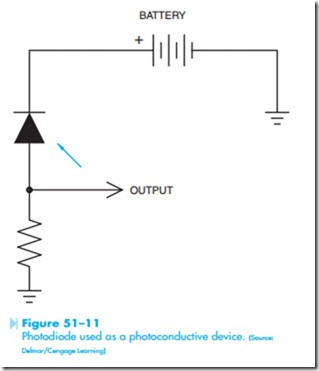PHOTODIODES
The photodiode is so named because of its response to a light source. Photodiodes are housed in a case that has a window that permits light to strike the semiconductor material, Figure 51–9. Photodiodes can be used in two basic ways.
Photovoltaic
Photodiodes can be used as photovoltaic devices. When in the presence of light, they will produce a voltage in a manner similar to that of solar cells. The output voltage is approximately 0.45 volts. The current capacity is small and use is generally limited to applications such as operating light-metering devices. The basic schematic for a photodiode used as a photovoltaic device is shown in Figure 51–10.
Note the symbol used to represent a photo diode. The arrow pointing toward the diode indicates that it must receive light to operate.
Photoconductive
Photodiodes can also be used as photoconductive devices. When used in this manner they are connected reverse biased, Figure 51–11. In the presence of darkness, the amount of reverse current flow is extremely small, similar to that of a junction diode connected reverse biased. This current is referred to as the dark current (ID) and is generally in the range of a few nanoamperes. For most practical purposes dark current is generally considered to be zero.
When exposed to light, photons enter the depletion region and create electron-hole pairs,
increasing conductivity in the reverse direction. The increased conduction may permit several milliamperes of current to flow. This is known as light current (IL). The great advantage of the photodiode over other photoconductive devices, such as the cad cell, is speed of operation. Photodiodes can operate at very high frequencies.
